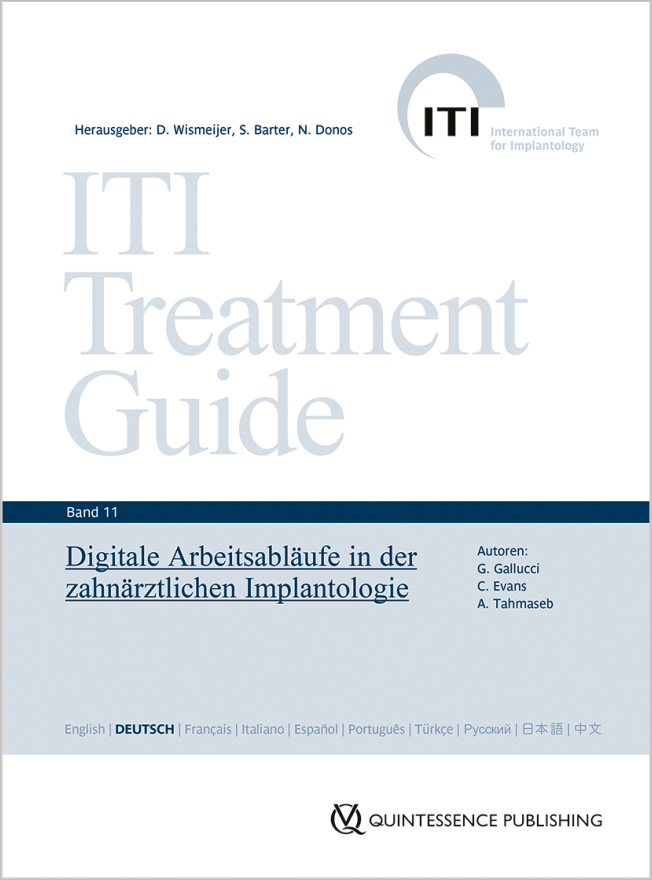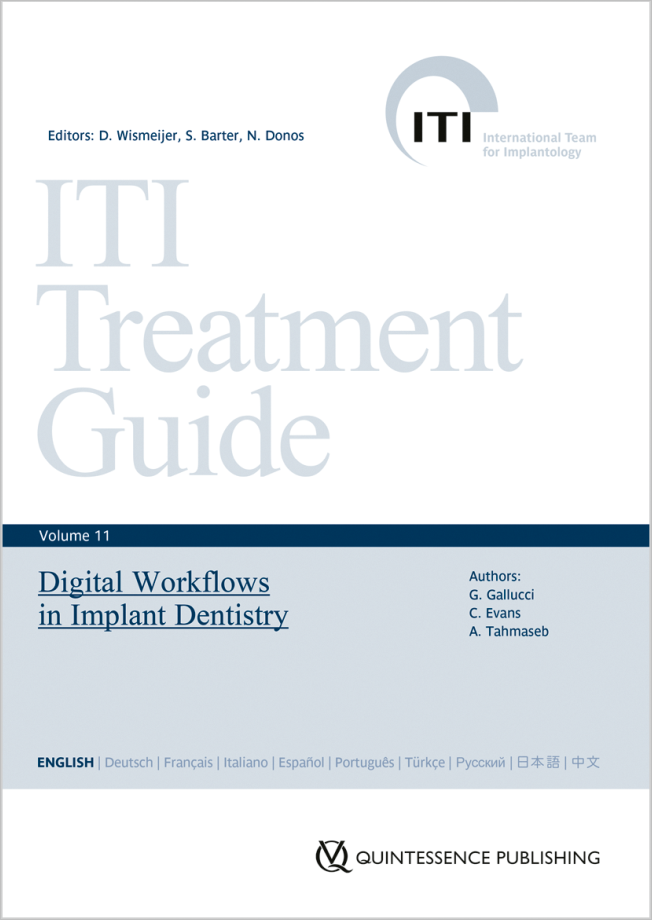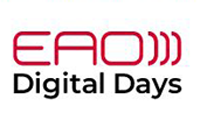International Journal of Periodontics & Restorative Dentistry, 1/2023
Online OnlyDOI: 10.11607/prd.5711, PubMed ID (PMID): 36661881Pages e35-e42, Language: EnglishTabassum, Afsheen / Wismeijer, Daniel / Hogervorst, J M A / Siddiqui, Intisar Ahmad / Kazmi, Farhat / Tahmaseb, AliAutogenous particulate bone grafts are being utilized in oral implantology for minor grafting procedures. This study aimed to investigate the influence of the bone-harvesting technique, donor age, and donor site on proliferation and differentiation of human primary osteoblast-like cells in the cell culture. Autogenous bone particles (20 samples) were harvested from the maxilla and mandible during surgery using two different protocols, and two types of particulate bone grafts were collected: bone chips and bone sludge. Bone samples were cultured in growth medium and, after 2 to 3 weeks, the cells that grew from bone grafts were cultured in the normal and osteogenic medium for 0, 4, 7, and 20 days. DNA, alkaline-phosphatase (ALP), calcium-content measurements, and Alizarin red/toluidine blue staining were performed. Data were analyzed by repeated-measures analysis of variance with Bonferroni test. The level of statistical significance was set at 5% (P < .05). Total DNA, ALP, and calcium content were significantly higher for the bone chip samples compared to the bone sludge samples. Total DNA and ALP content were significantly higher for the patients in age group 1 (≤ 60 years) compared to age group 2 (> 60 years) and was significantly higher for mandibular samples than maxillary samples on day 20. However, the calcium measurement showed no significant difference concerning donor age and donor site. Data analysis revealed that harvesting technique (bone chips vs bone sludge), donor age (≤ 60 years vs > 60 years), and donor site (maxilla vs mandible) influenced the osteogenic potential of the collected particulate bone graft. The bone chips were superior in terms of osteogenic efficacy and should be considered a suitable option for particulate bone graft collection.
The International Journal of Prosthodontics, 6/2021
DOI: 10.11607/ijp.7074Pages 733-743, Language: EnglishDerksen, Wiebe / Tahmaseb, Ali / Wismeijer, Daniel
Purpose: To compare the fit and clinical performance of screw-retained monolithic zirconia implant fixed dental prostheses (FDPs) based on either intraoral optical scanning (IOS) or conventional impressions.
Materials and methods: Patients with two posterior tissue-level implants (Straumann Regular Neck) replacing two or three adjacent teeth were recruited. Impressions were taken with both IOS (True Definition Scanner, 3M ESPE) and a conventional (polyether) pick-up impression. Double-blind randomization was performed after impression-taking, and patients were to receive an FDP based on either the digital or the conventional impression. The fit was evaluated, and the time required for adjustments was recorded. Additionally, survival and technical complication rates with a follow-up of 1 year were documented.
Results: A total of 38 patients requiring 45 FDPs were included: 24 FDPs in the test (IOS) and 21 in the control (conventional) group. The average adjustment time was 6.92 minutes (SD: ± 10.84, range: 0 to 49 minutes) for digital vs 12.38 minutes (SD: ± 14.52, range: 0 to 54 minutes) for conventional impressions (P = .090). A proper fit (no adjustments) was achieved in 33.3% of the digital and 28.6% of the conventional group. Forty-two FDPs could be placed within the two planned appointments, and 3 FDPs exhibited an unacceptable fit and required an extra appointment. Eight technical complications occurred during the first year of function. The overall restoration survival rate was 100%.
Conclusion: The clinical fit of CAD/CAM FDPs based on digital impressions is comparable to conventional impressions. Screw-retained monolithic zirconia FDPs on Ti-base abutments show low major complication and survival rates in the short term.
The International Journal of Oral & Maxillofacial Implants, 6/2021
Online OnlyDOI: 10.11607/jomi.9029Pages e175-e182, Language: EnglishTabassum, Afsheen / Kazmi, Farhat / Wismeijer, Daniel / Siddiqui, Intisar Ahmad / Tahmaseb, Ali
Purpose: There is a substantial need to perform studies to evaluate crestal bone loss (CBL) and implant success when using a newly introduced low-speed drilling protocol. Therefore, this study aimed to evaluate the mean CBL and implant success rate by placing implants utilizing two drilling protocols, ie, standard and low-speed drilling protocols.
Materials and methods: A randomized controlled clinical trial was carried out in patients who required dental implants to restore their esthetics and function. The patients were recruited from a university hospital (Academic Centre for Dentistry Amsterdam [ACTA], the Netherlands). Based on the inclusion criteria, patients were randomized to two study groups: (1) control group, standard drilling protocol; and (2) test group, low-speed drilling protocol without saline irrigation. The mean CBL and the implant success rate were evaluated after 12 months of implant placement.
Results: Twenty-three patients (15 men and 8 women with a mean age of 57.5 ± 10.7 years) contributed to the study. Forty Camlog screw-line implants were placed (20 implants per study group). After 12 months of implant placement, the mean CBL of implants placed with the standard protocol and the low-speed protocol was 0.206 ± 0.251 mm and 0.196 ± 0.178 mm, respectively. No statistically significant difference could be recorded among both groups (P = .885). Concerning implants placed in the maxilla, the standard drilling group and low-speed drilling group showed a mean CBL of 0.252 ± 0.175 mm and 0.251 ± 0.175 mm, respectively, compared with 0.173 ± 0.210 mm and 0.141 ± 0.172 mm in the mandible, with no significant difference. The success rate of dental implants at 12 months was 95% in the control group and 90% in the test group.
Conclusion: Within the limitations of this study, it can be concluded that implants placed with the low-speed drilling protocol without saline irrigation exhibited a similar CBL compared with implants placed with the standard drilling protocol. However, a higher success rate was recorded especially in type 1-quality bone for the control group compared with the test group. Further randomized clinical trials with greater sample sizes and extended follow-up times should be performed to obtain stronger evidence and a better understanding of the influence of drilling speed on mean CBL and long-term implant success.
Keywords: crestal bone loss, dental implant, low-speed drilling, standard drilling
International Journal of Computerized Dentistry, 2/2021
ApplicationPubMed ID (PMID): 34085502Pages 165-179, Language: English, GermanLanis, Alejandro / Tahmaseb, AliComputer-assisted implant surgery is one of the techniques that has gained much popularity over the past years. The amount of information that can be managed in a virtual environment allows for a faster, safer, and more precise implant placement. In certain cases, an appropriate implant-supported rehabilitation is accompanied by the need for complementary surgical procedures. The present technique report describes a clinical situation in which a bone reduction template and a stackable implant placement guide were digitally designed and 3D printed for a simultaneous ridge ostectomy and computer-assisted implant placement.
Keywords: computer-assisted, computer-guided, 3D printing, implant surgery, implant placement, bone reduction
The International Journal of Oral & Maxillofacial Implants, 2/2020
DOI: 10.11607/jomi.7751, PubMed ID (PMID): 32142578Pages 406-414, Language: EnglishJonker, Brend P. / Wolvius, Eppo B. / van der Tas, Justin T. / Tahmaseb, Ali / Pijpe, JustinPurpose: When encountering a buccal bone defect during implant placement, guided bone regeneration (GBR) is a well-accepted method for bone reconstruction. However, it is still unclear if the esthetic and patient-reported outcomes are comparable to implants placed in native bone. The purpose of this prospective trial was to compare implants placed with a GBR procedure for a small (≤ 4 mm) buccal defect with implants placed completely in native bone (control).
Materials and Methods: Patients were allocated to the GBR group or control group during implant placement in the esthetic zone. Implants were placed after at least 12 weeks of healing of the extraction sockets. A buccal bone defect of ≤ 4 mm resulted in allocation to the GBR group. Follow-up was performed until 12 months after loading. Outcome measurements were as follows: esthetic scores, patient-reported outcome measurements, implant survival and complications, clinical indices, and radiographic measurements.
Results: In total, 45 patients were included, of which 23 underwent a GBR procedure after implant placement, and in 22 patients no GBR was necessary. No significant differences in esthetic outcomes were seen between the two groups. At the final follow-up, a mean pink esthetic score (PES) of 7.8 (SD: 1.5) was seen for the GBR group and 8.4 (SD: 1.4) for the control group. Regarding the white esthetic score (WES), a mean of 9.1 (SD: 1.0) was found for both groups. Patients of both groups were equally satisfied with their mucosa and crown. A mean visual analog score (VAS) for the soft tissues of 8.6 (SD: 1.0) in the GBR group and 8.8 (SD: 0.9) for the control group was noted. A mean VAS of 9.2 (SD: 0.8) was noted for the crown in the GBR group and 8.6 (SD: 2.0) in the control group. Implant survival was 100%, and there were no significant differences in complications, plaque/bleeding/ gingiva indices, width of attached mucosa, and marginal bone loss.
Conclusion: Implants placed in the esthetic zone with GBR or complete native bone coverage showed successful esthetic outcomes and satisfied patients with predictable clinical and radiographic parameters after more than 1 year of loading. Within the limits of this study, GBR for a small buccal bone defect seems to be a reliable technique with good esthetics and patientreported outcomes.
Keywords: esthetics, guided bone regeneration, patient-reported outcomes, prospective controlled clinical trial
The International Journal of Oral & Maxillofacial Implants, 1/2020
DOI: 10.11607/jomi.7648, PubMed ID (PMID): 31184630Pages 141-149, Language: EnglishTabassum, Afsheen / Wismeijer, Daniel / Hogervorst, J.M.A. / Tahmaseb, AliPurpose: Autogenous bone grafts are considered a "gold standard." The success of autografts mainly depends on their ability to promote an osteogenic response. The aim of this study was to collect autogenous bone during implant osteotomy preparation using two different drilling protocols and to evaluate and compare the proliferation and differentiation ability of the collected bone particles.
Materials and Methods: Autogenous bone particles were harvested from 20 patients during implant osteotomy preparation using two different drilling protocols: (1) standard drilling protocol with saline irrigation (according to the manufacturer's recommendation) and (2) low-speed drilling protocol without saline irrigation (speed 200 rpm). Collected bone samples were cultured in growth medium, and after 2 to 3 weeks, cells that grew out from bone grafts were cultured in the normal medium as well as in osteogenic medium for days 0, 4, 7, and 20. Scanning electron microscopy, alizarin red/toluidine blue staining, DNA, ALP, and calcium content measurements were performed. Repeated measures analysis of variance (ANOVA) with Bonferroni's test was employed to analyze the data of this study.
Results: The total DNA content was significantly higher for the low-speed drilling samples compared with the standard drilling on day 4 (P .05), day 7 (P .01), and day 20 (P .001) in the normal medium and on day 7 (P .01) and day 20 (P .01) in the osteogenic medium. Besides, calcium measurements and mineralized matrix formation observed with alizarin red/toluidine blue staining were significantly higher for the low-speed drilling group compared with the standard drilling group.
Conclusion: Osteogenic efficacy (differentiation and proliferation) of autogenous bone particles collected using low-speed drilling was superior compared with standard drilling samples.
Keywords: bone graft(s), bone remodeling/regeneration, cell differentiation, dental implants, mineralized tissue/development, osteoblast
The International Journal of Oral & Maxillofacial Implants, 2/2019
DOI: 10.11607/jomi.6980, PubMed ID (PMID): 30883624Pages 481-488, Language: EnglishZembic, Anja / Tahmaseb, Ali / Jung, Ronald E. / Wiedemeier, Daniel / Wismeijer, DanielPurpose: This cohort study evaluated patient satisfaction for maxillary implant-retained overdentures (IODs) on two implants up to 4 years and assessed the treatment effect over time.
Materials and Methods: Patients encountering problems with their conventional dentures were included and received maxillary IODs on two titanium-zirconium implants and ball anchors in the canine area. Patient satisfaction was assessed using the oral health impact profile (OHIP-20E) questionnaires both for dentures and IODs. Two months after insertion of IODs (baseline), the patients chose the preferred overdenture design with full or reduced palatal coverage. OHIP-20E questionnaires were followed according to the individual choice at 1 and 4 years, and outcomes were compared with baseline.
Results: Sixteen out of 21 patients were evaluated at a mean follow-up of 4 years (range: 2.4 to 4.8 years). There was no significant difference in the OHIP domains for IODs at 1 year (OHIP_total_1y: 9.5, SD: 13.0) and 4 years (OHIP_total_4y: 14.2, SD: 19.1) compared with baseline (OHIP_total_BL: 12.4, SD: 14.7). Patients were most satisfied with social disability both for IODs (OHIP_BL: 6.0, SD: 7.6; OHIP_1y: 3.4, SD: 5.4; OHIP_4y: 5.7, SD: 9.5) and dentures (OHIP_CD_old: 28, SD: 29.7; OHIP_CD_new: 25.4, SD: 28.67). Patients were least satisfied with functional limitation both for IODs (OHIP_BL: 6.0, SD: 7.6; OHIP_1y: 3.4, SD: 5.4; OHIP_4y: 5.7, SD: 9.5) and dentures (OHIP_CD_old: 28, SD: 29.7; OHIP_CD_new: 25.4, SD: 28.67).
Conclusion: Patient satisfaction with maxillary IODs on two implants did not change from baseline to 4 years and was high at 4 years of function.
Keywords: dental implants, dental prosthesis, edentulous, implant-supported, jaw, maxilla, overdenture, patient-reported outcomes, patient satisfaction, quality of life
2019-2
Pages 110-117, Language: EnglishTahmaseb, Ali / te Poel, Jobine / Wismeijer, DanielComputer Aided Implant Surgery (CAIS) has lately been gaining popularity among dental clinicians. Several software packages and associated tools are available on the market. Recent literature reviews show that inaccuracies often occur when these techniques are applied. In this article, the authors give an overview of the tools available for CAIS along with their benefits and shortcomings as well as possible solutions to improve overall accuracy in CAIS.
Keywords: Guided surgery, computer planning, CAIS
The International Journal of Oral & Maxillofacial Implants, 6/2017
DOI: 10.11607/jomi.5981, PubMed ID (PMID): 29140382Pages 1377-1388, Language: EnglishZygogiannis, Kostas / Aartman, Irene H. A. / Parsa, Azin / Tahmaseb, Ali / Wismeijer, DanielPurpose: The aim of this 1-year randomized trial was to evaluate and compare the clinical and radiographic performance of four immediately loaded mini dental implants (MDIs) and two immediately loaded standard-sized tissue-level (STL) implants, placed in the interforaminal region of the mandible and used to retain mandibular overdentures (IODs) in completely edentulous patients.
Materials and Methods: A total of 50 completely edentulous patients wearing conventional maxillary dentures and complaining about insufficient retention of their mandibular dentures were divided into two groups; 25 patients received four MDIs and 25 patients received two STL implants. The marginal bone loss (MBL) at the mesial and distal sides of each implant was assessed by means of standardized intraoral radiographs after a period of 1 year. Implant success and survival rates were also calculated.
Results: Immediate loading was possible for all patients in the first group. In the second group, an immediate loading protocol could not be applied for 10 patients. These patients were treated with a delayed loading protocol. A mean MBL of 0.42 ± 0.56 mm for the MDIs and 0.54 ± 0.49 mm for the immediately loaded STL implants was recorded at the end of the evaluation period. There was no statistically significant difference between the MDIs and the immediately loaded STL implants. Two MDIs failed, resulting in a survival rate of 98%. The success rate was 91%. For the immediately loaded conventional implants, the survival rate was 100% and the success rate 96.7% after 1 year of function. However, in 10 patients, the immediate loading protocol could not be followed.
Conclusion: Considering the limitations of this short-term clinical study, immediate loading of four unsplinted MDIs or two splinted STL implants to retain mandibular overdentures seems to be a feasible treatment option. The marginal bone level changes around the MDIs were well within the clinically acceptable range.
Keywords: immediate loading, implant overdentures, marginal bone loss, mini dental implants
2017-2
Pages 106-111, Language: EnglishTahmaseb, Ali / Wismeijer, DanielImplantology is already well integrated in modern dentistry. Dental implant procedures are increasingly performed by general dentists in general offices. Still, as the indication field has been extended enormously, the need for more skilled and trained clinicians has been a subject of intensive interest at numerous universities and academic settings around the world. Various dental schools have created one- to four-year, part-time or full-time implant programs as part of their postdoctoral residence program. In this article, the ACTA approach is explained.
Keywords: Implant dentistry, implant education








